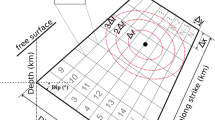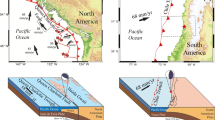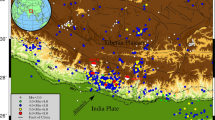Abstract
In order to understand physical processes of megathrust earthquakes, and thus to analyze hazards of the regions, proper information of the rupture processes is essential. In this study, we develop a technique for determination of large spatial-scale rupture processes on megathrust faults in subduction zones as soon as possible, based on teleseismic broadband full-waveform inversions using realistic models of finite fault geometries and 3D global velocity structures. Finite fault geometry models are constructed for eleven subduction zones of the circum-Pacific area, utilizing the 3D plate interface model Slab 1.0 of USGS. Green’s functions for available pairs of subfaults and globally distributed stations to be used in the inversions are computed in the global 3D velocity model using spectral element method rather than in a 1D velocity model. This scheme accommodates synthetic waves with lateral velocity variations especially for surface waves, which is useful in estimations of large spatial-scale slip distributions. The data utilized are teleseismic broadband full-waveform records including body waves and surface waves at the epicentral distance of 30º ~ 80º. The observed data are inverted for fault rupture processes, based on the non-negative least-square technique with a multiple source time window scheme for each subfault. The applicability of the method is tested for the 2011 Mw 9.0 Tohoku-Oki earthquake, and the result shows that the proposed scheme of the finite fault inversion produces reasonable results of slip distributions.







Similar content being viewed by others
References
Ammon, C. J., Lay, T., Kanamori, H., & Cleveland, M. (2011). A rupture model of the 2011 off the Pacific coast of Tohoku earthquake. Earth Planets and Space,63, 693–696. https://doi.org/10.5047/eps.2011.05.015.
Ammon, C. J., Velasco, A. A., & Lay, T. (2006). Rapid estimation of first-order rupture characteristics for large earthquakes using surface waves: 2004 Sumatra-Andaman earthquake. Geophysical Research Letters. https://doi.org/10.1029/2006gl026303.
Ammon, C. J., et al. (2005). Rupture process of the Sumatra-Andaman earthquake. Science,308, 1133–1139. https://doi.org/10.1126/science.1112260.
Bassin, C., Laske, G., & Masters, G. (2000). The current limits of resolution for surface wave tomography in North America. EoS, Transactions American Geophysical Union,81, F897.
Berger, M. J., George, D. L., LeVeque, R. J., & Mandli, K. T. (2011). The GeoClaw software for depth-averaged flows with adaptive refinement. Advances in Water Resources, 34(9), 1195–1206.
Bletery, Q., Sladen, A., Delouis, B., Vallée, M., Nocquet, J.-M., Rolland, L., et al. (2014). A detailed source model for theMw9.0 Tohoku-Oki earthquake reconciling geodesy, seismology, and tsunami records. Journal of Geophysical Research,119, 7636–7653. https://doi.org/10.1002/2014jb011261.
Clawpack Development Team. (2014). Clawpack Version 5.2.0. http://www.clawpack.org.
Delouis, B., Nocquet, J-M., & Vallée, M. (2010). Slip distribution of the February 27, 2010 Mw = 8.8 Maule Earthquake, central Chile, from static and high-rate GPS, InSAR, and broadband teleseismic data. Geophysical Research Letters, 37, L17305. https://doi.org/10.1029/2010GL043899.
Duputel, Z., Rivera, L., Kanamori, H., Hayes, G. P., Hirshorn, B., & Weinstein, S. (2011). Real-time W phase inversion during the 2011 off the Pacific coast of Tohoku earthquake. Earth Planets and Space,63, 535–539. https://doi.org/10.5047/eps.2011.05.032.
Goda, K., Yasuda, T., Mori, N., & Maruyama, T. (2018). New scaling relationships of earthquake source parameters for Stochastic Tsunami simulation. Coastal Engineering Journal,58, 1650010–1650011. https://doi.org/10.1142/s0578563416500108.
Hartzell, S., & Heaton, T. (1983). Inversion of strong ground motion and teleseismic waveform data for the fault rupture history of the 1979 Imperial Valley, California, earthquake. Bulletin of Seismological Society of America,73, 1553–1583.
Hayes, G. P. (2011). Rapid source characterization of the 2011 Mw 9.0 off the Pacific coast of Tohoku earthquake. Earth Planets Space,63, 529–534.
Hayes, G. P., Wald, D. J., & Johnson, R. L. (2012). Slab1.0: A three-dimensional model of global subduction zone geometries. Journal of Geophysical Research. https://doi.org/10.1029/2011jb008524.
Ji, C., Wald, D. J., & Helmberger, D. V. (2002). Source description of the 1999 hector mine, California, earthquake, Part II: Complexity of slip history. Bulletin of the Seismological Society of America,92, 1208–1226.
Koketsu, K., et al. (2011). A unified source model for the Tohoku earthquake. Earth and Planetary Science Letters,310, 480–487. https://doi.org/10.1016/j.epsl.2011.09.009.
Kustowski, B., Ekström, G., & Dziewoński, A. M. (2008). Anisotropic shear-wave velocity structure of the Earth’s mantle: A global model. Journal of Geophysical Research. https://doi.org/10.1029/2007jb005169.
Lawson, C. L., & Hanson, R. J. (1995). Solving least squares problems. Philadelphia: SIAM.
Lay, T., Ammon, C. J., Kanamori, H., Koper, K. D., Sufri, O., & Hutko, A. R. (2010). Teleseismic inversion for rupture process of the 27 February 2010 Chile (Mw 8.8) earthquake. Geophysical Research Letters,37, L13301. https://doi.org/10.1029/2010gl043379.
Lay, T., Ammon, C. J., Kanamori, H., Xue, L., & Kim, M. (2011). Possible large near-trench slip during the 2011Mw9.0 off the Pacific coast of Tohoku earthquake. Earth Planets and Space,63, 687–692. https://doi.org/10.5047/eps.2011.05.033.
Lay, T., et al. (2005). The great Sumatra-Andaman earthquake of 26 december 2004. Science,308, 1127–1133.
Lee, S.-J., Huang, B.-S., Ando, M., Chiu, H.-C., & Wang, J.-H. (2011). Evidence of large scale repeating slip during the 2011 Tohoku-Oki earthquake. Geophysical Research Letters. https://doi.org/10.1029/2011gl049580.
LeVeque, R. J., George, D. L., & Berger, M. J. (2011). Tsunami modelling with adaptively refined finite volume methods. Acta Numerica, 20, 211–289.
Mai, P. M. (2012). Finite-Source Rupture Model Database. http://equake-rc.info/SRCMOD. Accessed 5 June 2019.
Mai, P. M., & Beroza, G. C. (2002). A spatial random field model to characterize complexity in earthquake slip. Journal of Geophysical Research. https://doi.org/10.1029/2001jb000588.
Mai, P. M., & Thingbaijam, K. K. S. (2014). SRCMOD: An online database of finite-fault rupture models. Seismological Research Letters,85, 1348–1357. https://doi.org/10.1785/0220140077.
Okada, Y. (1992). Internal deformation due to shear and tensile faults in a half-space. Bulletin of Seismological Society of America,82, 1018–1040.
Olson, A. H., & Apsel, R. J. (1982). Finite faults and inverse theory with application to the 1979 imperial valley earthquake. Bulletin of Seismological Society of America,72, 1969–2001.
Rhie, J., Dreger, D., Burgmann, R., & Romanowicz, B. (2007). Slip of the 2004 Sumatra-Andaman earthquake from joint inversion of long-period global seismic waveforms and gps static offsets. Bulletin of the Seismological Society of America,97, S115–S127. https://doi.org/10.1785/0120050620.
Shao, G., Li, X., Ji, C., & Maeda, T. (2011). Focal mechanism and slip history of the 2011 M w 9.1 off the Pacific coast of Tohoku Earthquake, constrained with teleseismic body and surface waves. Earth Planets and Space,63, 559–564. https://doi.org/10.5047/eps.2011.06.028.
Simons, M., et al. (2011). The 2011 magnitude 9.0 Tohoku-Oki earthquake: mosaicking the megathrust from seconds to centuries. Science,332, 1421–1425. https://doi.org/10.1126/science.1206731.
Suzuki, W., Aoi, S., Sekiguchi, H., & Kunugi, T. (2011). Rupture process of the 2011 Tohoku-Oki mega-thrust earthquake (M9.0) inverted from strong-motion data. Geophysical Research Letters. https://doi.org/10.1029/2011gl049136.
Tajima, F., Mori, J., & Kennett, B. L. N. (2012). A review of the 2011 Tohoku-Oki earthquake (Mw 9.0): Large-scale rupture across heterogeneous plate coupling. Tectonophysics,586, 15–34. https://doi.org/10.1016/j.tecto.2012.09.014.
Tang, L., et al. (2012). Direct energy estimation of the 2011 Japan tsunami using deep-ocean pressure measurements. Journal of Geophysical Research. https://doi.org/10.1029/2011jc007635.
Tromp, J., Komatitsch, D., & Liu, Q. (2008). Spectral-element and adjoint methods in seismology. Communications in Computational Physics,3, 1–32.
Wei, Y., Newman, A. V., Hayes, G. P., Titov, V. V., & Tang, L. (2014). Tsunami forecast by joint inversion of real-time tsunami waveforms and seismic or GPS data: Application to the Tohoku 2011 tsunami. Pure and Applied Geophysics,171, 3281–3305. https://doi.org/10.1007/s00024-014-0777-z.
Whitmore, P. M. (2009). Chapter 13 in the sea. Tsunami warning systems (Vol. 15). Cambridge: Harvard University Press.
Yoshida, Y., Ueno, H., Muto, D., & Aoki, S. (2011). Source process of the 2011 off the Pacific coast of Tohoku Earthquake with the combination of teleseismic and strong motion data. Earth Planets and Space,63, 565–569. https://doi.org/10.5047/eps.2011.05.011.
Yoshimoto, M., & Yamanaka, Y. (2014). Teleseismic inversion of the 2004 Sumatra-Andaman earthquake rupture process using complete Green’s functions. Earth Planets and Space,66, 1–8.
Yue, H., & Lay, T. (2013). Source Rupture Models for the Mw 9.0 2011 Tohoku earthquake from joint inversions of high-rate geodetic and seismic data. Bulletin of the Seismological Society of America,103, 1242–1255. https://doi.org/10.1785/0120120119.
Acknowledgements
This study was supported by the ‘Research and development for Numerical Weather Prediction and Earthquake services in KMA’ project of the Korea Meterological Administration. And we would like to thank Professor Thorne Lay for constructive criticism, and Dr. Hwasung Cheon for statistical analysis of the calculated Green’s functions. The funding was provided by Korea Meteorological Administration.
Author information
Authors and Affiliations
Corresponding author
Additional information
Publisher's Note
Springer Nature remains neutral with regard to jurisdictional claims in published maps and institutional affiliations.
Electronic supplementary material
Below is the link to the electronic supplementary material.
Rights and permissions
About this article
Cite this article
Baag, SY., Rhie, J., Yoo, SH. et al. Determination of Megathrust Rupture Processes Using Plate-Interface-Based Fault Models and 3D Green’s Functions: An Application to the 2011 Mw 9.1 Tohoku Earthquake. Pure Appl. Geophys. 176, 5235–5252 (2019). https://doi.org/10.1007/s00024-019-02272-7
Received:
Revised:
Accepted:
Published:
Issue Date:
DOI: https://doi.org/10.1007/s00024-019-02272-7




